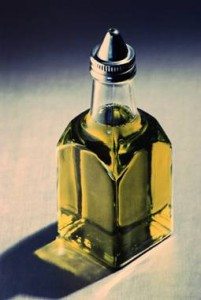Ilana Katz MS, RD, CSSD
There has been much debate about the healthiness of different oils in the nutrition media lately. With the boost on research and essential fats, oils, some of which do offer the good source of fat to our daily intake needs some analysis. The reason why I want to blog on this is although many have been deemed healthy, depending on whether you use them for cooking or not, may change their chemistry. In other words, heating various oil sources can create free radicals which in turn lead to inflammation. Free radicals are unstable byproducts of the body’s cells use of oxygen to produce energy.
One of the components of immunity is a reserve of antioxidants, helping boost the body’s systems of defense against internal cell damage from free radicals. However, even though the human body has these innate mechanisms that protect against microscopic invaders, the increase in free radicals generated during strenuous exercise may degrade the immune system. Athletes therefore have a particular concern to protect the immune system with antioxidants in their diet. Another point of concern to keep free radicals to a minimum, believe it or not, is cooking. Certain oils, if heated to above what is called their smoke point (the temperature at which they begin to smoke), also create free radicals. Once a fat starts to smoke, it usually will emit a harsh smell and fill the air with smoke. Watch out for the smoke point signs as it means that the oil is close to the flash point. Flash point is when the oil will erupt into flames.
Nutrition and health experts have been pushing many healthy oils for many years now, particularly since poly-unsaturated fats, mono-unsaturated fats and Omega-3 essential fats have been shown to increase health and lower cholesterol. But have they warned you of the dangers of heating some of these oils past the smoke point. Many people have a tendency to cook in olive oil, believing that olive oil is one of the good fats. Olive oil, is in fact better at lower temperature uses such as salad dressings and preferably not for heating uses such as frying and sautéing (well, when is frying ever healthy, huh? Couldn’t resist that as my food policing gene is ever present).
Some of the higher smoke points for healthy oil are found in sesame oil and canola oil. Typically most nutty oils have higher smoke points than regular vegetable oils. Smoke points in fact vary rather widely and are affected by various factors. For example, refining oils (taking out impurities) tends to increase the smoke point.
Factors that will decrease the smoke point include:
- Combination of vegetable oils in products
- Presence of foreign properties (like batter or salt )
- The more time the same oil is used
- Storage of oil (exposure to oxygen, light, temperature)
- The time the oil is being heated for
The ideal cooking oil should contain higher amounts of monounsaturated and polyunsaturated fats, with a minimal or no saturated fats and trans fats. The best oils for cooking and frying are those that have a high smoking point because they can be heated to high temperatures before burning. Knowing the smoke point warn you about the flash point and fire points. At the flash point, there are tiny wisps of flame; at the fire point a fire is blazing:
Table of some common oils smoke points:
| TYPE OF OIL | SMOKE PT (0F) | TYPE | BEST USE |
| REFINED | |||
| Almond | 495 | ||
| Avocado | 520 | ||
| Canola / Rapeseed | 400 | ||
| Corn | 450 | ||
| Grapeseed | 400 | ||
| Olive | 300-400(virgin/extra virgin/light) | Mono-unsat | |
| Peanut | 450 | mono | |
| Safflower | 450 | ||
| Sesame | 410 | ||
| Soybean | 450 | ||
| Sunflower | 450 | Mono | |
| Vegetable (blended) | |||
| UNREFINED | |||
| Corn | |||
| Coconut | |||
| Grapeseed | |||
| Nut blends | |||
| Olive | |||
| Peanut | |||
| Pumpkin Seed | |||
| Safflower | |||
| Sesame | |||
| Soybean | |||
| Sunflower | |||
| Vegetable (blended) | |||
The best oils for deep-frying and high temperatures are refined safflower and sunflower oils, peanut, safflower and soy oils. Refined almond, avocado and cottonseed oil are also great if you can find them, and be warned, they are pretty expensive (should you be deep frying anyway? Here I go, food policing again).
Refining of oils is a process to produce clear oil, free from rancidity and foreign matter. These oils are used as medium cooking oils (225°F – 350°F), high cooking oils (350°F – 450°F), and deep-frying oils (greater than 450°F).
Fully refined oil tends to be paler in color, bleached, and deodorized, with a minimal flavor and/or aroma. Thus these oils are more effective for dishes needing only a delicate and light flavor. They are more useful for baking and sautéing, stir-fry and wok-fry, and oven cooking; to sear or brown.
Unrefined oils are typically called salad oils and are used for salad dressings, marinades, and sauces and only very low forms of heat in cooked dishes (light sautés and low heat baking). Unrefined oils are processed by cold-pressed methods. Some examples are olive, corn, sesame seeds, peanuts, soybeans, and safflower oils. The strong flavors of unrefined oils can dominate whatever dish or baked good is made with them and are often used as flavoring agents. As a general rule, they should not be heated to high temperatures. One exception is safflower oil, as it is the one unrefined oil that can become hot enough to reach the temperature necessary frying. Unrefined oil contains a full range of bioactive components that have healthful benefits and provide full-bodied flavor. The strong natural flavor and aroma also hint at their higher amounts of nutritional value. Unfortunately they are more prone to oxidation. Using unrefined oils at temperatures above 320°F accelerates the oxidation of these oils. Best for medium heat temperature range: 212°F – 320°F.
In Summary:
Different fats and oils have different uses. Each performs best within a certain range of temperature. Some are made for high heat cooking, while others have intense flavors that are best enjoyed by drizzling directly on food. How we cook may now be as important as the choice of foods. Some simple modifications may provide positive reduction of inflammation.


